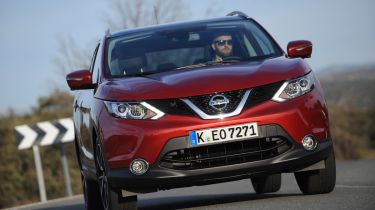Nissan Qashqai Tekna 2014 review
We test top-spec 2014 Nissan Qashqai Tekna with punchy 1.2-litre petrol

The Nissan Qashqai Tekna mixes class-leading comfort and whisper-quiet refinement with composed and secure handling and a dazzlingly hi-tech cabin. Plus, the petrol-powered Qashqai is every bit as impressive as the diesel versions. The increase in size could alienate those who prized the original’s compact proportions, but the extra space is hard to argue with, and Nissan should prepare itself for another sales smash.
The Nissan Qashqai has been a phenomenal success story, with nearly 50,000 examples of the crossover sold in the UK during 2013 – outstripping the new BMW 3 Series.
Such big numbers meant the pressure was on the company to deliver with the all-new model, which comes in four main trim levels: Visia, Acenta, Acenta Premium and Tekna. We’ve already been bowled over by the Nissan Qashqai diesel, as well as the Nissan Qashqai automatic - but what about the top-spec Nissan Qashqai Tekna?
• Full Nissan Qashqai review
New design and grown-up driving dynamics are evolutionary steps, but what really sets the Qashqai Tekna apart in the increasingly crowded crossover market is its intelligent use of technology. While most of the gadgets have already been seen on other cars, many are new to the class, and their sheer number ensures the newcomer feels a step ahead of the competition.
Used - available now

2022 Nissan
Qashqai
21,428 milesManualPetrol1.3L
Cash £16,097
2022 Nissan
Qashqai
23,928 milesManualPetrol1.3L
Cash £13,680
2022 Nissan
Qashqai
16,320 milesAutomaticPetrol1.3L
Cash £17,150
2020 Nissan
Qashqai
8,612 milesManualPetrol1.3L
Cash £15,968The Tekna model's list of equipment is extensive: it includes Bluetooth, cruise control, hill-start assist, dual-zone air-conditioning, automatic lights and wipers, DAB radio, a 7-inch touchscreen display, a rear-view parking camera.
It also features a panoramic glass roof, LED headlights and 19-inch alloy wheels, as well as a full leather interior, heated seats, intelligent park assist and electric seats.
The five-inch TFT display between the dials is a real highlight, and the bigger touchscreen in the centre console is clearer and easier to use than ever before, with smartphone connectivity and in-car apps.
• Nissan Qashqai diesel 2014 review
Nissan expects almost half of all Qashqais sold to be 1.2 and 1.6-litre DiG-T models (DiG-T stands for Direct injection gasoline turbocharged, in case you’re wondering). So can they really match the dCi diesels for refinement and driveability? We tested the 113bhp 1.2-litre model in Tekna trim to find out.
The new small turbo is essentially a replacement for the naturally aspirated 1.6-litre found in the outgoing Qashqai. Not only is it lighter than the old engine, it’s cleaner and more powerful, too. Despite the new car’s increased weight, the tiny 1.2-litre takes it from 0-62mph in 11.3 seconds – over half a second faster than the old 1.6. Better still, CO2 emissions have fallen by 10g/km to just 129g/km, too.
On the road, you soon notice the car’s increase in size. It’s longer and wider than before, and instantly feels more substantial from behind the wheel. The new electronic power-steering is surprisingly heavy, and it gives the Qashqai the same secure, stable feeling you get in much bigger 4x4s.
The handling is safe and reassuring, with loads of grip and minimal body roll – even in really sharp bends – and the new Chassis Control electronics help to keep things neat and tidy on challenging roads. Clever double-piston rear shock absorbers give the Qashqai a supple low-speed ride, even though the old multi-link rear axle has been ditched in favour of a lighter, simpler, twist beam set-up.
• Nissan Qashqai automatic review
There is a flat spot in performance below 1,500rpm before the turbo spools up, so you have to choose your ratio in the six-speed manual gearbox carefully, but the 190Nm of torque available in the mid-range is just about enough to keep the car ticking along with other traffic. Refinement at idle is truly exceptional, with not even a whisper of engine noise making it through to the cabin.
Work it hard and explore the upper edges of the rev range, however, and it can begin to sound strained. It lacks the eagerness and smooth power delivery of the less potent 1.2 TSI in the Skoda Yeti, although the Yeti is lighter.


